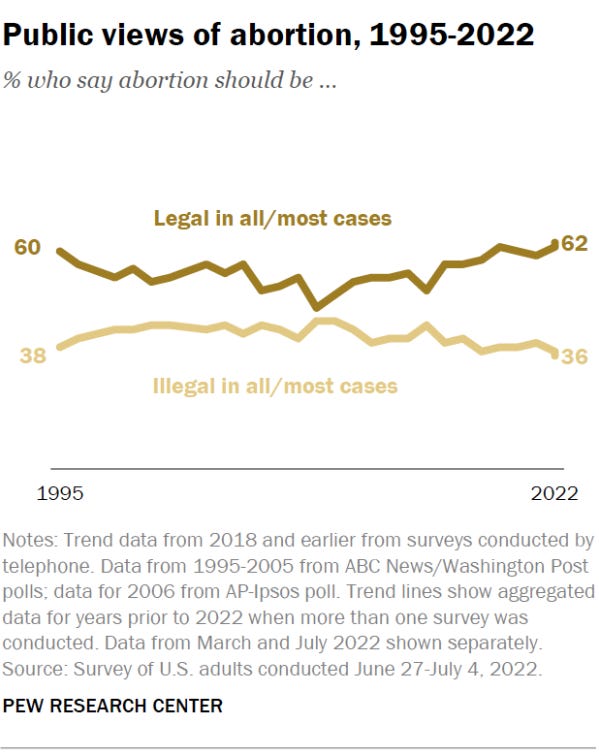Five Key Facts About Abortion
This is essentially a summary of a video of mine in which I discuss this same topic more briefly. These facts are:
Abortion bans are broadly ineffective;
Abortion restrictions lead to more unsafe abortions;
Abortion restrictions lead to worse health outcomes for women and children;
"Pro-lifers" are not actually "pro-life";
The majority of Americans support women’s reproductive rights.
1. Abortion bans are broadly ineffective
According to estimates by the Guttmacher institute, during the period between 2010 - 2014 the abortion rate did not differ significantly between countries that restricted abortion and those that don’t restrict abortions. In the most restrictive countries the abortion rate was 37 per 1000 women, while in countries with no restrictions as to reason the rate was 34 per 1000 women.1
This is further supported by their estimates for the period between 2015 - 2019. They found that in countries where abortion was broadly legal the abortion rate was 40 per 1000 women, while in countries where abortion is permitted only to save the life of the woman the abortion rate was 36 per 1000 women, and in countries where abortion is prohibited altogether the rate was also 40 per 1000 women.2
They also found that when excluding India and China from the “abortion broadly legal” group, as they skew the results due to atypically high abortion rates, abortions actually occurred less frequently in the most permissive countries, at a rate of 26 per 1000 women.
2. Abortion restrictions lead to more unsafe abortions
Not only do abortion bans seem broadly ineffective, they also lead to more women having unsafe abortions. According to the 2017 report by the Guttmacher institute, in the most restrictive countries 74.9% of abortions fell in the less or least safe categories. In countries classified as moderately restrictive this was 57.9%, while in the least restrictive countries only 12.6% of abortions were classified as less or least safe.1
3. Abortion restrictions lead to worse health outcomes for women and children
A 2017 report by the Center for Reproductive Rights and Ibis Reproductive Health analyzed the relationship between abortion restrictions and indicators of women’s and children’s well-being, finding a negative relationship across all variables.3
4. “Pro-lifers” are not actually “pro-life”
A 2014 study analyzed the data of more than 7400 people and found that “perceptions of preborn humanness explained very little of right–left differences in abortion support, and the association between preborn humanness perceptions and abortion opposition was no stronger for those on the political right (vs. left).”4 And a 2022 poll by Pew also found that a third of Americans simultaneously believe that a fetus is a person with rights and that the decision to abort should be up to the woman. This means that the majority of people who believe that life starts at conception (about 59%) still believe that women should have the right to an abortion.10
By contrast, a 2017 study found that sexism accounted for 30% to 70% of the left-right difference in abortion stance even after controlling for other relevant variables.5 An earlier study found that authoritarianism had a significant correlation with an anti-abortion position and aggression towards women,6 and a 2019 study found that right-wing authoritarianism had a significant correlation with anti-abortion stigma both before and after controlling for other variables.7
5. The majority of Americans support women’s reproductive rights
According to research by Pew 62% of Americans believe that abortions should be legal in all or most cases, and 57% disapprove of the Supreme Court’s decision to overturn Roe v. Wade.8 Even in what are otherwise very red states, such as Kansas, people are voting to maintain women’s reproductive rights because most Americans don’t want their freedoms taken away.9
The Supreme Court’s decision to strike Roe v. Wade and state legislators enacting abortion bans is simply authoritarianism: A minority of unelected officials restricting people’s freedoms despite it going completely against what the American people actually want.
Sources
[1] Abortion Worldwide 2017: Uneven Progress and Unequal Access
https://www.guttmacher.org/report/abortion-worldwide-2017
[2] Unintended pregnancy and abortion by income, region, and the legal status of abortion: estimates from a comprehensive model for 1990-2019
https://www.thelancet.com/journals/langlo/article/PIIS2214-109X(20)30315-6/fulltext
[3] Evaluating priorities: Measuring women's and children's health and well-being against abortion restrictions in the states
https://www.reproductiverights.org/sites/default/files/documents/USPA-Ibis-Evaluating-Priorities-v2.pdf
[4] Does "humanization" of the preborn explain why conservatives (vs. liberals) oppose abortion?
https://www.sciencedirect.com/science/article/abs/pii/S0191886913013676
[5] Can left-right differences in abortion support be explained by sexism?
https://www.sciencedirect.com/science/article/abs/pii/S0191886916308868
[6] Authoritarianism and Gender Roles: Toward a Psychological Analysis of Hegemonic Relationships
https://journals.sagepub.com/doi/abs/10.1177/0146167297231005
[7] Hostile sexism and Right-Wing Authoritarianism as mediators of the relationship between sexual disgust and abortion stigmatizing attitudes
https://www.sciencedirect.com/science/article/abs/pii/S019188691930460X
[8] Majority of Public Disapproves of Supreme Court’s Decision To Overturn Roe v. Wade
https://www.pewresearch.org/politics/2022/07/06/majority-of-public-disapproves-of-supreme-courts-decision-to-overturn-roe-v-wade/#americans-views-of-abortion
[9] Kansas recount confirms abortion rights victory
https://www.nbcnews.com/politics/kansas-recount-confirms-abortion-rights-victory-rcna44199
[10] One-in-three adults say both that human life begins at conception and that the decision to have an abortion belongs solely to the woman
https://www.pewresearch.org/religion/?p=37521








